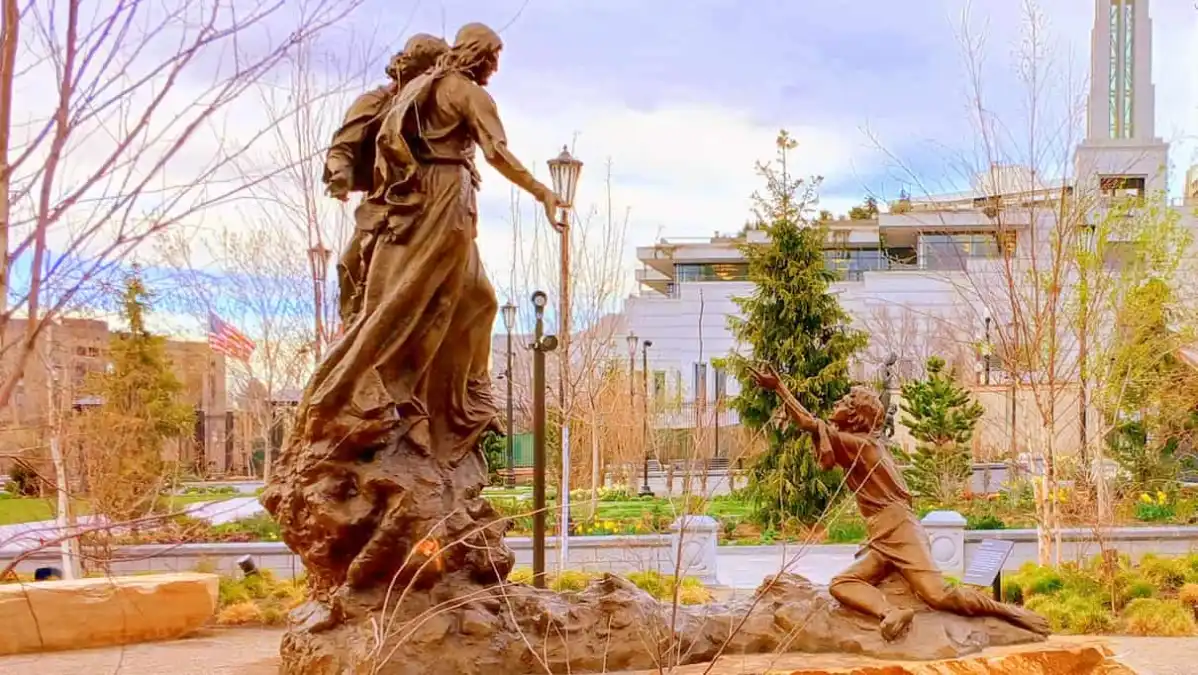Category: From the Desk Co-posts
-
Rosalynde Welch on Christ in the Doctrine and Covenants
I really appreciate the ways in which Rosalynde Welch approaches scriptures and interpretation of scriptures. I’ve mentioned this in my review of Seven Visions of Christ in the Doctrine and Covenants, but Rosalynde also shared some of her insights in a recent interview at the Latter-day Saint history site, From the Desk. What follows here is…
-
Evolution and First Presidency Statements
BYU’s new book on Evolution and the Gospel of Jesus Christ may yet prove to be the most important contribution to literature for Church members out of the new Mormon Studies Books in 2025. If nothing else, the analytical tools and frameworks it introduces to members makes it worth reading. in a recent interview at…
-
John Turner’s Experience with Joseph Smith
One of the big ticket items among 2025’s Mormon Studies books is John Turner’s Joseph Smith biography. It was officially released earlier this week, though I published my review earlier this month. In addition, however, John Turner recently shared some of his thoughts on the book in an interview at the Latter-day Saint history blog,…
-
Words of Brigham Young
One of the most important initiatives using primary sources from the Church History Library has been LaJean Carruth’s efforts to transcribe George D. Watt’s shorthand records. Her work has elucidated insights into early Utah history and the speeches of Church leaders that were previously unavailable. Over the course of her work, LaJean Purcell Carruth has…
-
On The Restored Gospel of Jesus Christ and Evolution
There has been some recent excitement in the Latter-day Saint scholarly community about the recent publication of BYU Life Sciences, The Restored Gospel of Jesus Christ and Evolution. It’s a publication that’s been years in the making, and highly anticipated during the last few years, so it’s good to see it come to fruition. Co-editor…
-
On Vienna Jaques
The Doctrine and Covenants very rarely mentions women. In fact, it only mentions two contemporary women by name: Emma Hale Smith and Vienna Jaques. The former is by far the better known of the two, but Vienna Jaques is remarkable, for a few reasons. In a recent interview at the Latter-day Saint history blog From…
-

A New Look at the 1832 Account of the First Vision
The 1832 account of the First Vision has always been treated as the black sheep of the family when it comes to contemporary accounts of that event. It is the most unique out of the accounts in several ways. Kyle Beshears recently published a chapter, giving an important explanation of some of those differences. He…
-
A History of Young Women’s Organizations in the Church
The Church Historian’s Press recently published a history of the Young Women’s organization in the Church entitled Carry On: The Latter-day Saint Young Women Organization, 1870–2024. In connection with the release of this landmark study, Lisa Olsen Tait discussed the book in a recent interview at the Latter-day Saint history blog From the Desk. What follows…
-
Samuel Weber on Adam-God Doctrine
One observation about Brigham Young—particularly when it comes to his most controversial ideas, like the Adam-God teachings—is that he tended to take ideas from Joseph Smith and then amplify them. The priesthood and temple ban on individuals with black African ancestry, for example, can be seen as an expansion of things Joseph Smith accepted and…
-
On a New Edition of Teachings of the Prophet Joseph Smith
When I was on my mission, there were a few hot commodities on the book market that most of the missionaries wanted to get their hands on. Foremost among them were Teachings of the Prophet Joseph Smith and Joseph Smith: Rough Stone Rolling, with bookstores in Nauvoo, Illinois being the location in my mission where missionaries could…
-
On Section 25
The reading associated with this week in “Come, Follow Me” includes section 25 of the Doctrine and Covenants, the revelation addressed to Emma Hale Smith. Luckily, the Latter-day Saint history blog From the Desk published an interview with Robin Jensen on that very subject, including a great discussion about how the revelations were a collaborative…
-
The 1930s Crisis in the Church in Mexico
The history of the Church around the world is still a developing field and while Mexico is one of the countries that has received attention, Fernando Gomez‘s A Documentary History of the Church of Jesus Christ of Latter-Day Saints in Mexico, 1875-1946 shows that there is still more to learn and discover about the history of…
-
Who Translated the Book of Mormon?
What if the Book of Mormon was translated from an ancient language into modern English, but it wasn’t God or Joseph Smith who did the translation? If so, did Moroni translate the Book of Mormon? That’s the very theory that Roger Terry has suggested, based on Royal Skousen’s research into the Book of Mormon. He…
-
Portuguese Panic for the Book of Mormon
A key moment in the Church’s establishment in different locations and cultures—including among countries like Brazil, where the Church officially has over one million members—is the translation of the Book of Mormon. Especially in earlier years, the effort was performed by missionaries with rudimentary knowledge of the language working with locals to create the translation,…
-
The Impact of Julian of Norwich
The woman known as Julian of Norwich was a mystic and a visionary who offered a theology that was focused on God’s love. She is a somewhat obscure figure, but one who is worth learning about. To that end, Fiona Givens discussed Julian of Norwich in a recent post at the Latter-day Saint history blog From…
-
The Adventures of Jacob Hamblin
With American Primeval, Netflix has once again put Mormonism in its sights as the subject in a drama, this time including the Mountain Meadows Massacre (the latest in a long line of portrayals of that event). While that event casts a long shadow over nineteenth century Mormonism’s experience in the western United States, there are…
-
Matthew Bowman on Joseph Fielding Smith
Joseph Fielding Smith was one of the movers and shapers of The Church of Jesus Christ of Latter-day Saints throughout the twentieth century. Although lacking in professional training in theology or history, his impact in those areas can still be felt today in the Church. In a recent interview at the Latter-day Saint history blog…
-
Weekly Observance of the Sacrament
The Sacrament of the Lord’s Supper is one the most common ritual and use of set ritual prayers in The Church of Jesus Christ of Latter-day Saints. Weekly observance is a high frequency compared to many Christian denominations’ observance of similar rites and begs to question of why we observe it so frequently. David F.…
-

The Paris Art Mission
I love that Latter-day Saint temples tend to be well-decorated with artwork, including the temple murals. I still find it a bit painful that the murals were not preserved as part of the Salt Lake City Temple renovation, but still find the history of the original murals in the Salt Lake City Temple to be…
-
Slavery vs Unfree Labor in Utah
Slavery is one of the darkest subjects in the history of the United States. It was an issue that impacted so many lives (in ways that echo through to the present day) and arguments over it tore the nation apart. Utah Territory was no different in that they were caught in intense debates over the…
-
Moroni and Temple Sites
Moroni is an important figure in Latter-day Saint lore. For example, I’ve written previously about how some authors have taken any mention of angels and the Book of Mormon in the same story as a reference to Moroni, whether that conclusion is warranted or not. But another area in which Moroni plays a role is…
-
Symbols in the Wilford Woodruff Journals
Early last year, I wrote about symbols I had observed in Wilford Woodruff’s journals. It turns out that I wasn’t the only person who had that on the mind – Joshua Matson had done some earlier and more intensive research on the same topic that he shared in a presentation at the Building Latter-day Faith…
-
Baseball Baptisms and the British Mission
Missionary service is a time of growth and an opportunity to serve, but it can also be a source of extreme pressures and stress for missionaries that manifests in different ways. One of the more famous examples came in the 1950s in the British Isles, where pressure from a mission president led to people taking…
-
On Marion D. Hanks
Marion D. Hanks is one of the most influential general authorities who never served in the Quorum of the Twelve or First Presidency. Today he is best known for his hymn, “That Easter Morn”, his advocating for Christlike service, and the support he lent to Black members of the Church in the years leading up…
-
Historical Narratives and the Pharisees
Growing up in the Church, I repeatedly heard stories where missionaries encountered people who had been reading anti-Mormon literature and told them that “you wouldn’t decide on which car to buy by reading only the stuff put out by a company’s competitors – you would also read what the company that produced the car has…
-
Proto New Mormon History
The “New Mormon History” was an era when Latter-day Saint historians began to rely on the techniques of modern academic and professional historians in their approach to research and writing about the Church. Leonard J. Arrington is, in many ways, the face of this movement and was given the moniker of “the Father of Mormon…
-
The Kirtland Temple Endowment
In modern Latter-day Saint terminology, the Endowment is a specific ordinance performed in temples around the world. In the first temple to be constructed by church members (the House of the Lord in Kirtland), however, the term has a somewhat different meaning. In a recent interview at the Latter-day Saint history blog From the Desk,…
-
An Abbreviated Journal of Discourses
While Bruce R. McConkie’s controversial Mormon Doctrine is famous in Latter-day Saint circles, it wasn’t his first controversial project. Prior to that time, he worked on preparing a “best-of” collection from the Journal of Discourses that was known as Sound Doctrine. The project was close to publication when the First Presidency intervened and shut it…
-
Smith Family Women
Joseph Smith grew up in a family with strong-willed women. Among those are two who left some notable records of the early Church, particularly Lucy Mack Smith (his mother) and Katharine Smith Salisbury (his sister). Two recent posts at the Latter-day Saint history site From the Desk discuss these two Smith family women and their…
-
John Turner on his Joseph Smith Biography
John Turner is known in Latter-day Saint circles for his biography of Brigham Young and his book The Mormon Jesus: A Biography. Next year, however, he will add to that collection with John Turner’s Joseph Smith biography. Turner recently spoke about the forthcoming biography with From the Desk, and announced that “I loved writing Joseph…
